File Info
| Exam | AWS Certified Solutions Architect - Associate |
| Number | SAA-C03 |
| File Name | Amazon.SAA-C03.VCEplus.2025-01-28.214q.vcex |
| Size | 398 KB |
| Posted | Jan 28, 2025 |
| Downloads: | 1 |
| Download | Amazon.SAA-C03.VCEplus.2025-01-28.214q.vcex |
How to open VCEX & EXAM Files?
Files with VCEX & EXAM extensions can be opened by ProfExam Simulator.
Coupon: MASTEREXAM
With discount: 20%
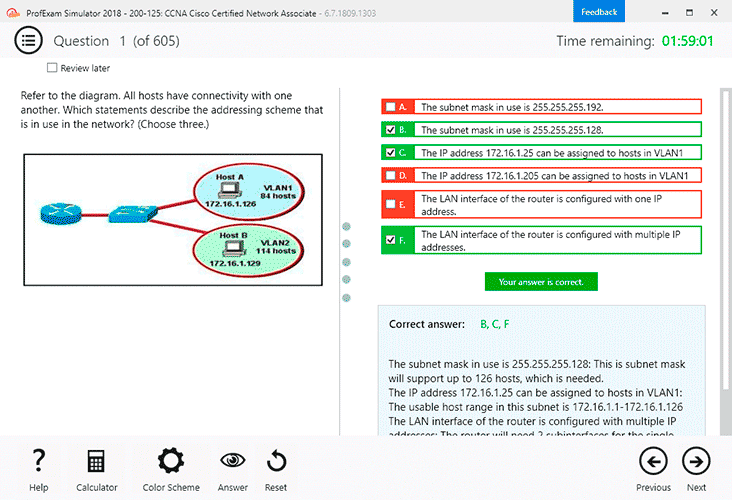
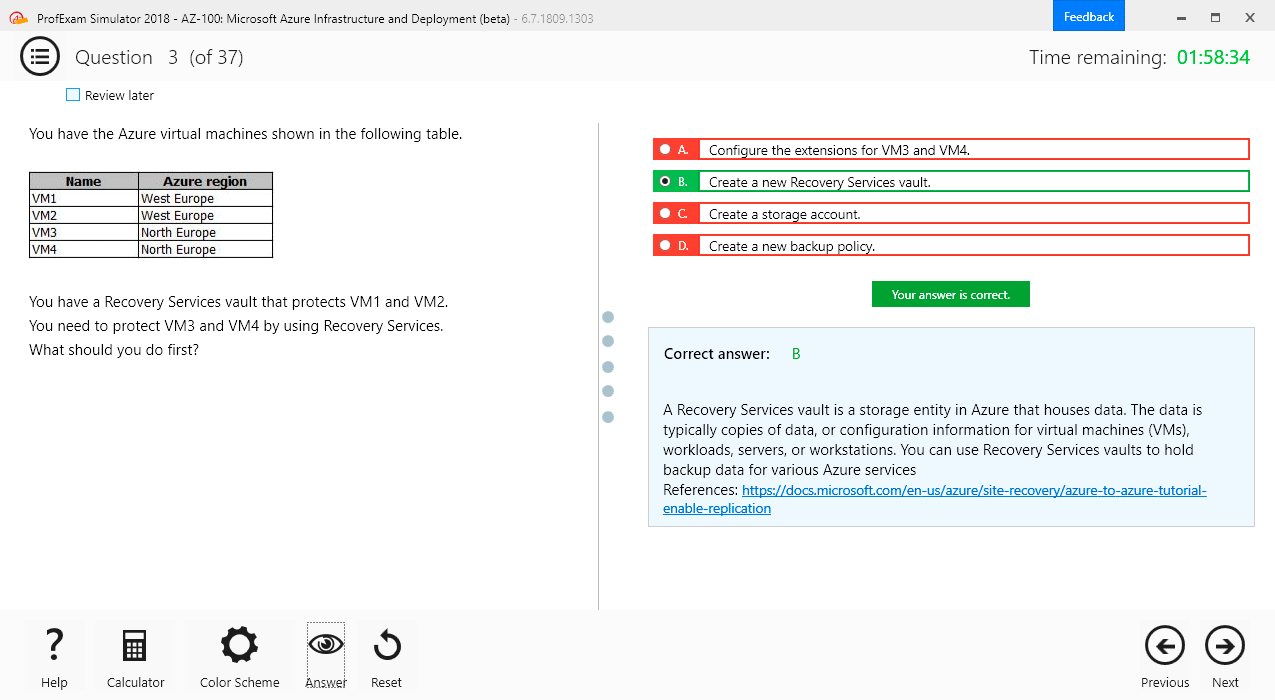
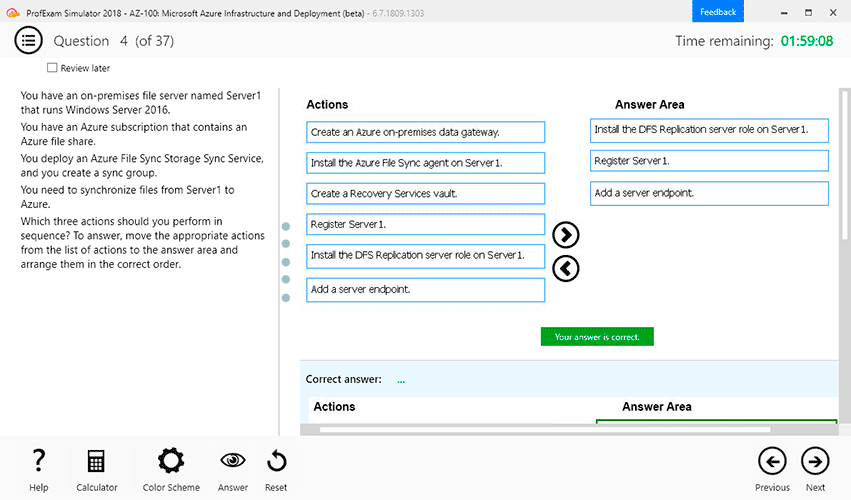
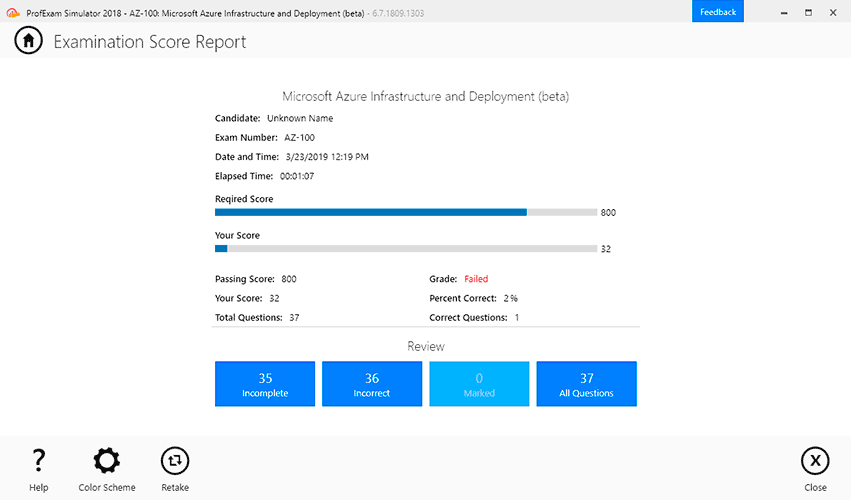
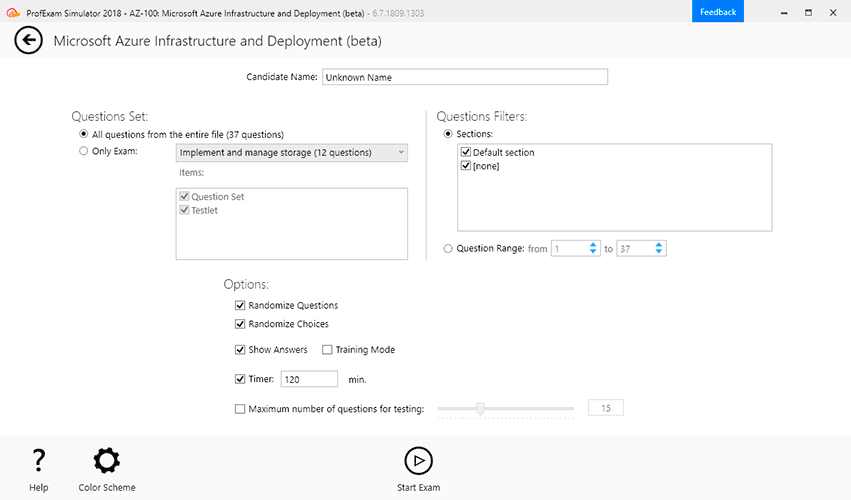

Demo Questions
Question 1
A company recently signed a contract with an AWS Managed Service Provider (MSP) Partner for help with an application migration initiative. A solutions architect needs to share an Amazon Machine Image (AMI) from an existing AWS account with the MSP Partner's AWS account. The AMI is backed by Amazon Elastic Block Store (Amazon EBS) and uses a customer managed customer master key (CMK) to encrypt EBS volume snapshots.
What is the MOST secure way for the solutions architect to share the AMI with the MSP Partner's AWS account?
- Make the encrypted AMI and snapshots publicly available. Modify the CMK's key policy to allow the MSP Partner's AWS account to use the key
- Modify the launchPermission property of the AMI. Share the AMI with the MSP Partner's AWS account only. Modify the CMK's key policy to allow the MSP Partner's AWS account to use the key.
- Modify the launchPermission property of the AMI Share the AMI with the MSP Partner's AWS account only. Modify the CMK's key policy to trust a new CMK that is owned by the MSP Partner for encryption.
- Export the AMI from the source account to an Amazon S3 bucket in the MSP Partner's AWS account. Encrypt the S3 bucket with a CMK that is owned by the MSP Partner Copy and launch the AMI in the MSP Partner'sAWS account.
Correct answer: B
Explanation:
Share the existing KMS key with the MSP external account because it has already been used toencrypt the AMI snapshot. Reference: https://docs.aws.amazon.com/kms/latest/developerguide/key-policyaccounts.html Share the existing KMS key with the MSP external account because it has already been used toencrypt the AMI snapshot.
Reference:
https://docs.aws.amazon.com/kms/latest/developerguide/key-policyaccounts.html
Question 2
A solutions architect is designing the cloud architecture for a new application being deployed on AWS. The process should run in parallel while adding and removing application nodes as needed based on the number of jobs to be processed. The processor application is stateless. The solutions architect must ensure that the application is loosely coupled and the job items are durably stored. Which design should the solutions architect use?
- Create an Amazon SNS topic to send the jobs that need to be processed Create an Amazon Machine Image (AMI) that consists of the processor application Create a launch configuration that uses the AMI Create an AutoScaling group using the launch configuration Set the scaling policy for the Auto Scaling group to add and remove nodes based on CPU usage
- Create an Amazon SQS queue to hold the jobs that need to be processed Create an Amazon Machine image (AMI) that consists of the processor application Create a launch configuration that uses the AM' Create an AutoScaling group using the launch configuration Set the scaling policy for the Auto Scaling group to add and remove nodes based on network usage
- Create an Amazon SQS queue to hold the jobs that needs to be processed Create an Amazon Machine image (AMI) that consists of the processor application Create a launch template that uses the AMI Create an AutoScaling group using the launch template Set the scaling policy for the Auto Scaling group to add and remove nodes based on the number of items in the SQS queue
- Create an Amazon SNS topic to send the jobs that need to be processed Create an Amazon Machine Image (AMI) that consists of the processor application Create a launch template that uses the AMI Create an AutoScaling group using the launch template Set the scaling policy for the Auto Scaling group to add and remove nodes based on the number of messages published to the SNS topic
Correct answer: C
Explanation:
"Create an Amazon SQS queue to hold the jobs that needs to be processed. Create an Amazon EC2 Auto Scaling group for the compute application. Set the scaling policy for the Auto Scaling group to add and remove nodes based on the number of items in the SQS queue" In this case we need to find a durable and loosely coupled solution for storing jobs. Amazon SQS is ideal for this use case and can be configured to use dynamic scaling based on the number of jobs waiting in the queue.To configure this scaling you can use the backlog per instance metric with the target value being the acceptable backlog per instance to maintain. You can calculate these numbers as follows: Backlog per instance: To calculate your backlog per instance, start with the ApproximateNumberOfMessages queue attribute to determine the length of the SQS queue "Create an Amazon SQS queue to hold the jobs that needs to be processed. Create an Amazon EC2 Auto Scaling group for the compute application. Set the scaling policy for the Auto Scaling group to add and remove nodes based on the number of items in the SQS queue" In this case we need to find a durable and loosely coupled solution for storing jobs. Amazon SQS is ideal for this use case and can be configured to use dynamic scaling based on the number of jobs waiting in the queue.To configure this scaling you can use the backlog per instance metric with the target value being the acceptable backlog per instance to maintain. You can calculate these numbers as follows: Backlog per instance: To calculate your backlog per instance, start with the ApproximateNumberOfMessages queue attribute to determine the length of the SQS queue
Question 3
A company hosts its web applications in the AWS Cloud. The company configures Elastic Load Balancers to use certificate that are imported into AWS Certificate Manager (ACM). The company's security team must be notified 30 days before the expiration of each certificate.
What should a solutions architect recommend to meet the requirement?
- Add a rule m ACM to publish a custom message to an Amazon Simple Notification Service (Amazon SNS) topic every day beginning 30 days before any certificate will expire.
- Create an AWS Config rule that checks for certificates that will expire within 30 days. Configure Amazon EventBridge (Amazon CloudWatch Events) to invoke a custom alert by way of Amazon Simple NotificationService (Amazon SNS) when AWS Config reports a noncompliant resource
- Use AWS trusted Advisor to check for certificates that will expire within to days. Create an Amazon CloudWatch alarm that is based on Trusted Advisor metrics for check status changes Configure the alarm to send acustom alert by way of Amazon Simple rectification Service (Amazon SNS)
- Create an Amazon EventBridge (Amazon CloudWatch Events) rule to detect any certificates that will expire within 30 days. Configure the rule to invoke an AWS Lambda function. Configure the Lambda function to send acustom alert by way of Amazon Simple Notification Service (Amazon SNS).
Correct answer: B
Explanation:
Reference: https://aws.amazon.com/premiumsupport/knowledge-center/acm-certificate-expiration/ Reference:
https://aws.amazon.com/premiumsupport/knowledge-center/acm-certificate-expiration/
Question 4
A company's dynamic website is hosted using on-premises servers in the United States. The company is launching its product in Europe, and it wants to optimize site loading times for new European users. The site's backend must remain in the United States. The product is being launched in a few days, and an immediate solution is needed. What should the solutions architect recommend?
- Launch an Amazon EC2 instance in us-east-1 and migrate the site to it.
- Move the website to Amazon S3. Use cross-Region replication between Regions.
- Use Amazon CloudFront with a custom origin pointing to the on-premises servers.
- Use an Amazon Route 53 geo-proximity routing policy pointing to on-premises servers.
Correct answer: C
Explanation:
https://aws.amazon.com/pt/blogs/aws/amazon-cloudfront-support-for-custom-origins/You can now create a CloudFront distribution using a custom origin. Each distribution will can point to an S3 or to a custom origin. This could be another storage service, or it could be something more interesting and more dynamic, such as an EC2 instance or even an Elastic Load Balancer https://aws.amazon.com/pt/blogs/aws/amazon-cloudfront-support-for-custom-origins/
You can now create a CloudFront distribution using a custom origin. Each distribution will can point to an S3 or to a custom origin. This could be another storage service, or it could be something more interesting and more dynamic, such as an EC2 instance or even an Elastic Load Balancer
Question 5
A company wants to reduce the cost of its existing three-tier web architecture. The web, application, and database servers are running on Amazon EC2 instances for the development, test, and production environments. The EC2 instances average 30% CPU utilization during peak hours and 10% CPU utilization during non-peak hours.
The production EC2 instances run 24 hours a day. The development and test EC2 instances run for at least 8 hours each day. The company plans to implement automation to stop the development and test EC2 instances when they are not in use.
Which EC2 instance purchasing solution will meet the company's requirements MOST costeffectively?
- Use Spot Instances for the production EC2 instances. Use Reserved Instances for the development and test EC2 instances.
- Use Reserved Instances for the production EC2 instances. Use On-Demand Instances for the development and test EC2 instances.
- Use Spot blocks for the production EC2 instances. Use Reserved Instances for the development and test EC2 instances.
- Use On-Demand Instances for the production EC2 instances. Use Spot blocks for the development and test EC2 instances.
Correct answer: B
Question 6
A company has a production web application in which users upload documents through a web interlace or a mobile app. According to a new regulatory requirement, new documents cannot be modified or deleted after they are stored. What should a solutions architect do to meet this requirement?
- Store the uploaded documents in an Amazon S3 bucket with S3 Versioning and S3 Object Lock enabled
- Store the uploaded documents in an Amazon S3 bucket. Configure an S3 Lifecycle policy to archive the documents periodically.
- Store the uploaded documents in an Amazon S3 bucket with S3 Versioning enabled Configure an ACL to restrict all access to read-only.
- Store the uploaded documents on an Amazon Elastic File System (Amazon EFS) volume. Access the data by mounting the volume in read-only mode.
Correct answer: A
Explanation:
Reference: https://docs.aws.amazon.com/AmazonS3/latest/userguide/object-lock-overview.html Reference:
https://docs.aws.amazon.com/AmazonS3/latest/userguide/object-lock-overview.html
Question 7
A company has several web servers that need to frequently access a common Amazon RDS MySQL Multi-AZ DB instance The company wants a secure method for the web servers to connect to the database while meeting a security requirement to rotate user credentials frequently.
Which solution meets these requirements?
- Store the database user credentials in AWS Secrets Manager Grant the necessary IAM permissions to allow the web servers to access AWS Secrets Manager
- Store the database user credentials in AWS Systems Manager OpsCenter Grant the necessary IAM permissions to allow the web servers to access OpsCenter
- Store the database user credentials in a secure Amazon S3 bucket Grant the necessary IAM permissions to allow the web servers to retrieve credentials and access the database.
- Store the database user credentials in files encrypted with AWS Key Management Service (AWS KMS) on the web server file system. The web server should be able to decrypt the files and access the database
Correct answer: A
Explanation:
AWS Secrets Manager helps you protect secrets needed to access your applications, services, and IT resources. The service enables you to easily rotate, manage, and retrieve database credentials, API keys, and other secrets throughout their lifecycle.https://docs.aws.amazon.com/secretsmanager/latest/userguide/intro.htmlSecrets Manager enables you to replace hardcoded credentials in your code, including passwords, with an API call to Secrets Manager to retrieve the secret programmatically. This helps ensure the secret can't be compromised by someone examining your code, because the secret no longer exists in the code. Also, you can configure Secrets Manager to automatically rotate the secret for you according to a specified schedule. This enables you to replace long-term secrets with short-term ones, significantly reducing the risk of compromise. AWS Secrets Manager helps you protect secrets needed to access your applications, services, and IT resources. The service enables you to easily rotate, manage, and retrieve database credentials, API keys, and other secrets throughout their lifecycle.
https://docs.aws.amazon.com/secretsmanager/latest/userguide/intro.html
Secrets Manager enables you to replace hardcoded credentials in your code, including passwords, with an API call to Secrets Manager to retrieve the secret programmatically. This helps ensure the secret can't be compromised by someone examining your code, because the secret no longer exists in the code. Also, you can configure Secrets Manager to automatically rotate the secret for you according to a specified schedule. This enables you to replace long-term secrets with short-term ones, significantly reducing the risk of compromise.
Question 8
A company is hosting a web application on AWS using a single Amazon EC2 instance that stores useruploaded documents in an Amazon EBS volume. For better scalability and availability, the company duplicated the architecture and created a second EC2 instance and EBS volume in another Availability Zone placing both behind an Application Load Balancer After completing this change, users reported that, each time they refreshed the website, they could see one subset of their documents or the other, but never all of the documents at the same time.
What should a solutions architect propose to ensure users see all of their documents at once?
- Copy the data so both EBS volumes contain all the documents.
- Configure the Application Load Balancer to direct a user to the server with the documents
- Copy the data from both EBS volumes to Amazon EFS Modify the application to save new documents to Amazon EFS
- Configure the Application Load Balancer to send the request to both servers Return each document from the correct server.
Correct answer: C
Question 9
A company uses NFS to store large video files in on-premises network attached storage. Each video file ranges in size from 1MB to 500 GB. The total storage is 70 TB and is no longer growing. The company decides to migrate the video files to Amazon S3. The company must migrate the video files as soon as possible while using the least possible network bandwidth. Which solution will meet these requirements?
- Create an S3 bucket Create an IAM role that has permissions to write to the S3 bucket. Use the AWS CLI to copy all files locally to the S3 bucket.
- Create an AWS Snowball Edge job. Receive a Snowball Edge device on premises. Use the Snowball Edge client to transfer data to the device. Return the device so that AWS can import the data into Amazon S3.
- Deploy an S3 File Gateway on premises. Create a public service endpoint to connect to the S3 File Gateway Create an S3 bucket Create a new NFS file share on the S3 File Gateway Point the new file share to the S3bucket. Transfer the data from the existing NFS file share to the S3 File Gateway.
- Set up an AWS Direct Connect connection between the on-premises network and AWS. Deploy an S3 File Gateway on premises. Create a public virtual interlace (VIF) to connect to the S3 File Gateway. Create an S3bucket. Create a new NFS file share on the S3 File Gateway. Point the new file share to the S3 bucket. Transfer the data from the existing NFS file share to the S3 File Gateway.
Correct answer: B
Explanation:
The basic difference between Snowball and Snowball Edge is the capacity they provide. Snowball provides a total of 50 TB or 80 TB, out of which 42 TB or 72 TB is available, while Amazon Snowball Edge provides 100 TB, out of which 83 TB is available. The basic difference between Snowball and Snowball Edge is the capacity they provide. Snowball provides a total of 50 TB or 80 TB, out of which 42 TB or 72 TB is available, while Amazon Snowball Edge provides 100 TB, out of which 83 TB is available.
Question 10
A company has an application that ingests incoming messages. These messages are then quickly consumed by dozens of other applications and microservices. The number of messages varies drastically and sometimes spikes as high as 100,000 each second.
The company wants to decouple the solution and increase scalability.
Which solution meets these requirements?
- Persist the messages to Amazon Kinesis Data Analytics. All the applications will read and process the messages.
- Deploy the application on Amazon EC2 instances in an Auto Scaling group, which scales the number of EC2 instances based on CPU metrics.
- Write the messages to Amazon Kinesis Data Streams with a single shard. All applications will read from the stream and process the messages.
- Publish the messages to an Amazon Simple Notification Service (Amazon SNS) topic with one or more Amazon Simple Queue Service (Amazon SQS) subscriptions. All applications then process the messages from the queues.
Correct answer: D
Explanation:
https://aws.amazon.com/sqs/features/By routing incoming requests to Amazon SQS, the company can decouple the job requests from the processing instances. This allows them to scale the number of instances based on the size of the queue, providing more resources when needed. Additionally, using an Auto Scaling group based on the queue size will automatically scale the number of instances up or down depending on the workload. Updating the software to read from the queue will allow it to process the job requests in a more efficient manner, improving the performance of the system. https://aws.amazon.com/sqs/features/
By routing incoming requests to Amazon SQS, the company can decouple the job requests from the processing instances. This allows them to scale the number of instances based on the size of the queue, providing more resources when needed. Additionally, using an Auto Scaling group based on the queue size will automatically scale the number of instances up or down depending on the workload. Updating the software to read from the queue will allow it to process the job requests in a more efficient manner, improving the performance of the system.

